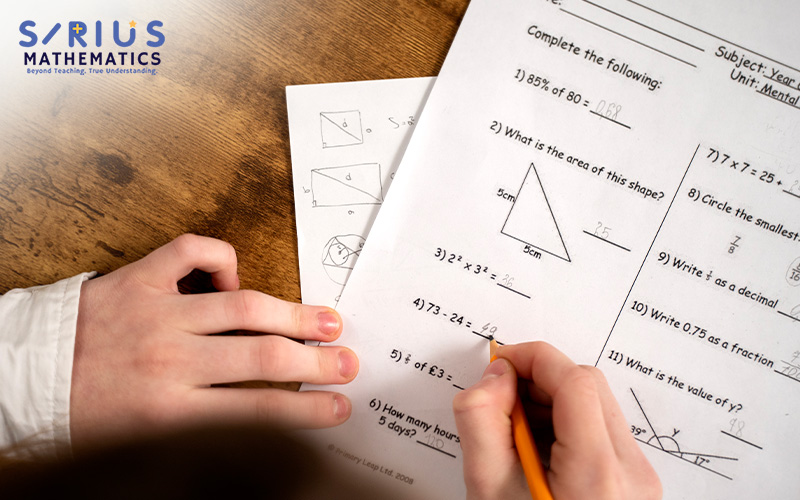Key Takeaways:
- How Can Recognising Recurring PSLE Math Question Types Give My Child an Advantage?
Mastering recurring PSLE Math question types gives students a real edge in tackling both routine and complex exam questions with confidence.
- Why Is the Right Math Tutor in Singapore Important for PSLE Success?
With the right guidance and strategic practice from experienced math tutors in Singapore, students can build the skills needed to approach these frequently tested concepts effectively and score higher in the PSLE.
Introduction
If your child is preparing for the PSLE, one thing remains constant every year: certain PSLE Math question types are simply unavoidable. These questions may reappear year after year as these core concepts form the main MOE Primary Mathematics syllabus. Recognising these “usual suspects” can give students a major advantage. The earlier they master these areas, the more confidently they can tackle tricky problems.
Let’s break down these Math question types and learn how students can solve them confidently.
What are Some Recurring PSLE Math Question Types?
1. Bar Model Word Problems (Fractions, Ratios, and Whole Numbers)
Bar model problem-solving is a staple in both Paper 1 and Paper 2. It helps students visualise part-whole relationships and compare quantities across topics like fractions, ratios, and whole numbers. From a “fraction of a remainder” to a changing ratio scenario, strong bar-modelling skills can make complex problems far more manageable. For instance, when a question involves multiple steps, drawing a bar model helps students keep track of each stage without getting overwhelmed. Sometimes, students lose marks because they forget to scale bars equally, miscount units, or skip an intermediate step. To avoid mixing “before” and “after” values, they should redraw bars after each change.
2. Units and Remainder Problems
These tricky questions often pop up in multi-step Paper 2 sections and test students’ understanding of division, multiplication, and proportional reasoning. They were featured in 7 of the last 10 PSLE Paper 2s. Known as the units and remainder strategy, these problems typically involve distributing items or tracking quantities that leave remainders.
Students usually lose marks from misinterpreting whether to round up/down or ignoring the meaning of the remainder in real-life contexts. To score well, they need to show each step clearly, even if they already know the answer mentally. Asking questions like, “Does the remainder mean a whole extra unit or something we ignore?” before finalising an answer helps to ensure accuracy.
3. Rate and Speed Questions
These questions are seen in 6 of the last 8 PSLEs. They involve the familiar formula:
Speed = Distance ÷ Time.
But don’t be fooled, these questions can get layered quickly. Students may need to interpret graphs or switch between units (like km/h and m/min), which often leads to errors if they rush. To tackle this, practise with word problems that involve both straightforward and combined rate scenarios. It is equally important to be fluent in unit conversions. If your child needs additional guidance, consider enrolling them in math tuition in SG.
4. Volume and Water Transfer Questions
Imagine a cuboid tank filling at a steady rate or two water levels changing at different speeds. These are classic examples of volume and water transfer questions, which appear often in PSLE Paper 2. They combine geometry, rate, and logic in one.

Diagrams can be deceptive, and the challenge often lies in visual interpretation. Students need to label carefully and understand what each part of the diagram represents before attempting calculations. Remember, the PSLE loves mixing volume with “rate per minute” or “how much remains”, so double-check units and timelines.
5. Before-and-After Math Scenarios (Ratio and Percentage)
These multiple-mark questions test a student’s ability to track changes in quantities over time or events. Known as before-and-after math scenarios, they often feature ratios, percentages, or both. Common themes include constant total or constant difference situations.
For example, a question may ask: “After giving away some apples, the ratio of apples to oranges becomes 3:5. How many were given away?” These problems are best tackled with a consistent comparison model or a units table. Bar models help by drawing “before” and “after” bars side by side can simplify tracking changes.
Why Knowing These PSLE Math Question Types Matters
By focusing on the aforementioned “repeat offenders” in PSLE Math questions, your child can train for what really matters. At Sirius Mathematics, our approach to math tutoring goes beyond drilling. We equip students with strategic problem-solving skills rooted in bar model problem solving, units and remainder strategy, and before-and-after math scenarios.
If you’re searching for a dedicated math tutor in Singapore, we’re here to strengthen your child’s confidence and results.
Reach out to check on the class availability.

